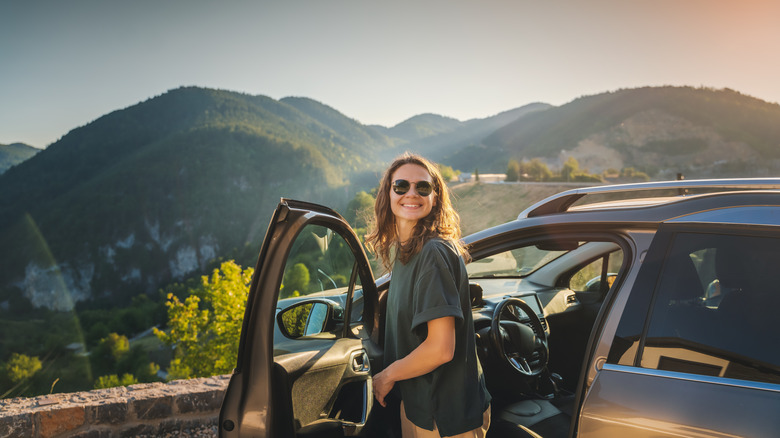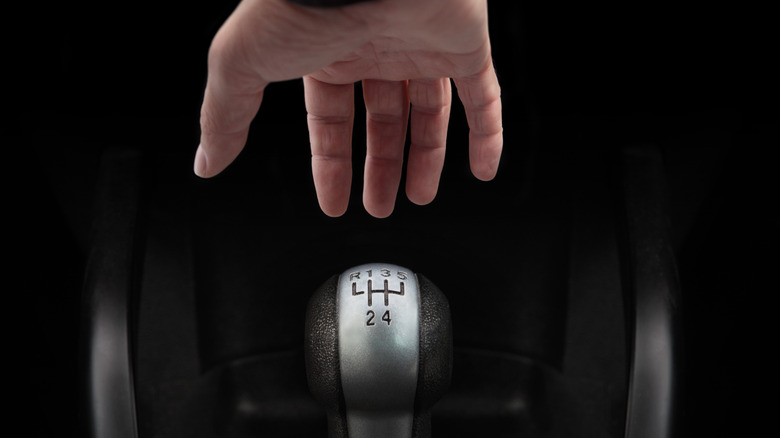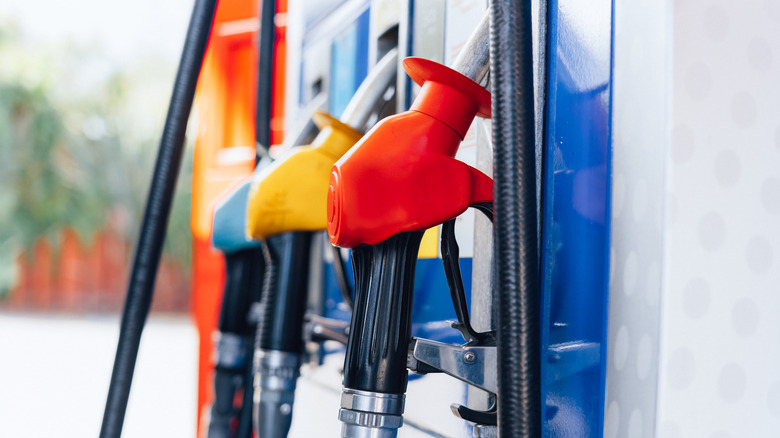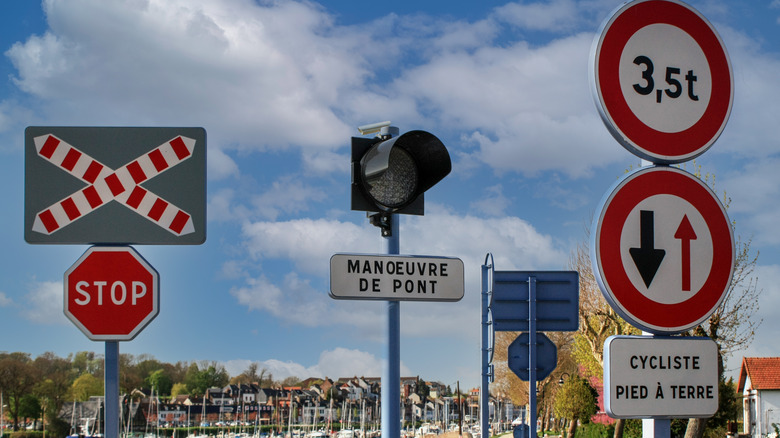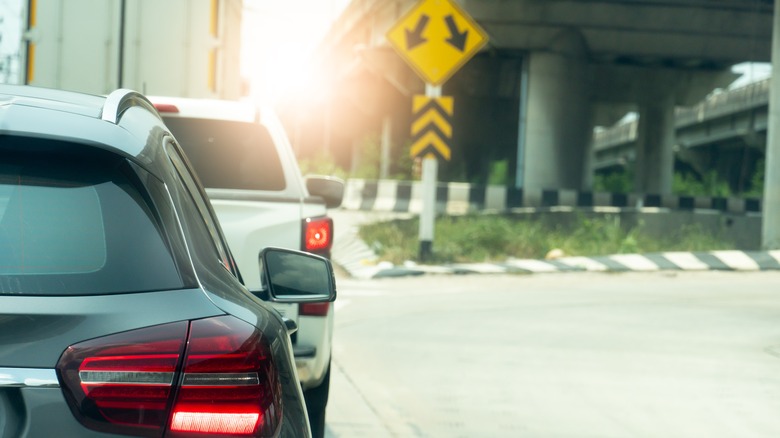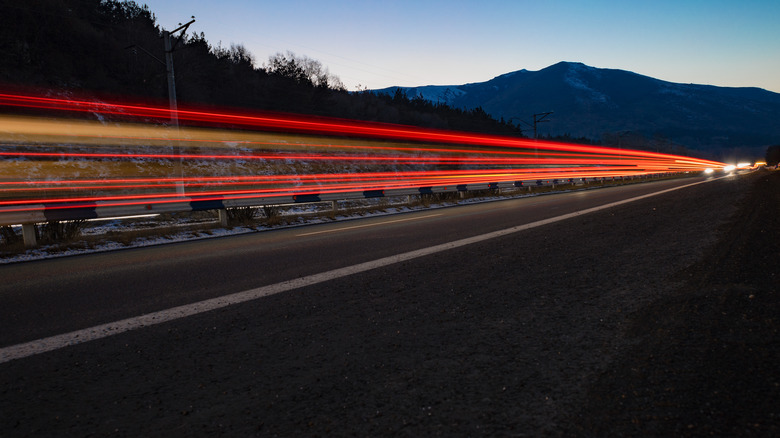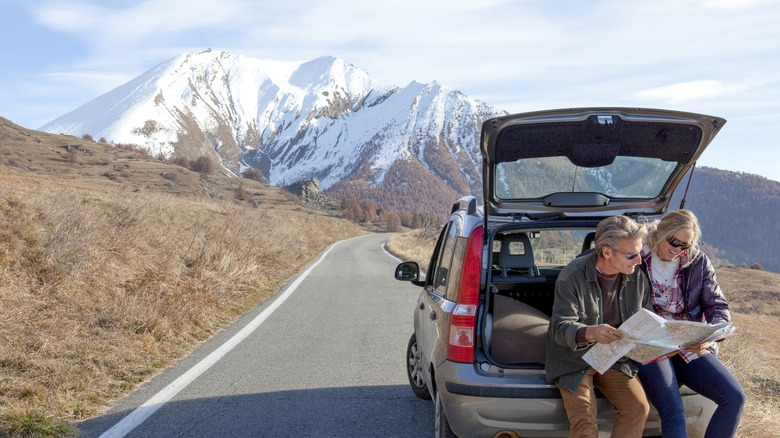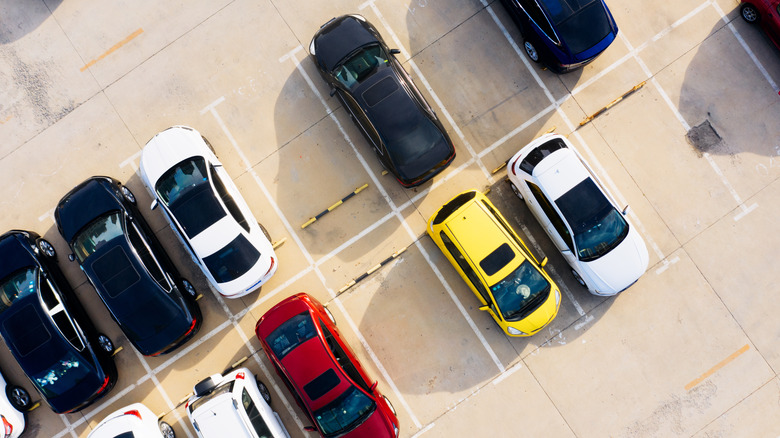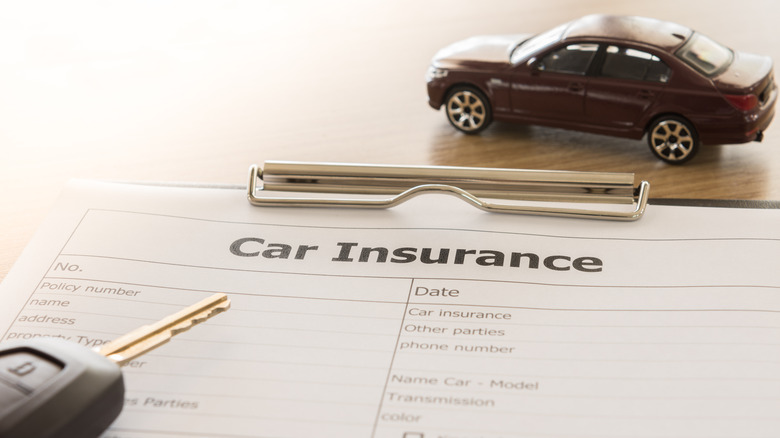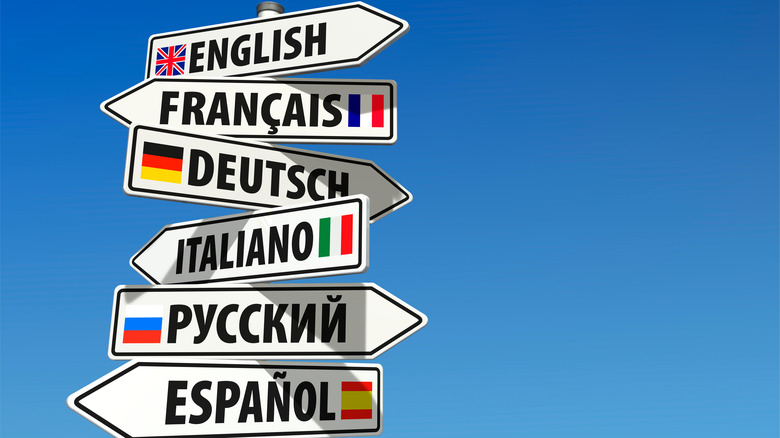Rick Steves' Best Tips For A Successful European Road Trip
Setting off on a road trip brings a variety of amazing vacationing features into play. In a car of your own, you can set the pace of travel, stop wherever you see fit, and call audibles with a moment's notice. No matter the impetus, road tripping allows you to change plans or timelines to suit the whims of the moment. Even more impactful, road trips allow for personal interaction between friends or family. Your companions will become closer to you through the experience, adding a depth of emotional riches alongside the fantastic journey itself.
It's these reasons that spark so many European road trips. The continent is overflowing with medieval towns you don't want to skip, off-the-beaten-path gems to escape the crowds, and picturesque national parks for a winter adventure. It's dotted with beaches, mountain vistas, and historical sites, too. But the continent isn't all smiles and easy highways. There are some key things to keep in mind when planning and executing a road trip anywhere in Europe.
For one, with 27 member nations in the European Union, transit through much of the continent is straightforward. But this doesn't mean that travelers can traverse the borders as if they were U.S. states. Similarly, unique road rules and driving habits impose themselves on travelers who aren't prepared for the task. Fortunately, Rick Steves knows a thing or two about driving in Europe and is more than willing to lay out some of his top tips for eager planners.
Don't overlook a car's transmission type
Many vehicles in Europe are run on a standard transmission. The difference might not sound all that important at first glance, but once you realize that most cars in the United States don't require their drivers to manually shift gears, the trouble becomes obvious. In a 2016 assessment, U.S. News & World Report found that on the low end, as few as 18% of Americans can drive a stick. This number has been decreasing over the years at a steady pace so it's possible that even fewer Americans today are equipped to handle this kind of automotive tool. As well, even for those who have experience with a manual transmission, jumping back into it on unfamiliar roads and potentially difficult terrain can certainly spell disaster.
Since these cars are so prevalent in Europe, you're almost certainly going to find them at rental agencies. Moreover, because drivers can take advantage of discounted rates by selecting a vehicle with a standard transmission, these cars will be listed near or at the top of the heap when sorting for price. If you are confident in your ability to drive a manual transmission, you will see a better cost on your road trip. However, it's also possible to accidentally select a vehicle that you aren't equipped to drive.
Be aware of your gasoline type
In addition to the mode of gear shifting as you make your way down the road, drivers will need to be aware of the fuel type required to power the vehicle. Diesel engines may not be all that common on routine commuter cars in the United States, but they are a standard propulsion option across the European Union. Diesel-powered cars get better gas mileage on the highway, and so some people in Europe opt to purchase diesel if they have a particularly long commute, among other reasons.
Regardless of the purpose, it's exceptionally important that you take note of the gasoline type required to continue on your journey touring Europe. Unleaded gasoline is known as petrol on the continent, and mixing fuels can have devastating effects. A petrol engine can't run on diesel, and the opposite is equally true. If you introduce the wrong fuel type into the gas tank, you'll have to wait for a mechanic to tow your vehicle and empty the entire gas tank. This issue becomes even more invasive if you have tried to drive for a while on a mixture and the wrong fuel enters the engine. Not only is solving this conundrum a time consuming and costly mistake, but you'll have to work out how to refill the entire fuel tank, get back on the road, and continue with your travel plans (both in the cost and logistics of remedying an empty fuel reserve).
Roll with the punches; there are bound to be a few
Steves notes that driving habits can seem far more aggressive in Europe. With smaller roads existing across much of the continent and many other factors coming into play, driving is just a different experience in Europe than it is in America. This difference can seem daunting, especially when you first take to the streets. After living and driving in Europe for the better part of the last decade, our takeaway is that driving is a more intuitive experience than in the United States. When navigating European driving, you'll almost certainly be traversing back roads and hidden community gems that are far off the beaten path of city bus routes and other routine public transit options. This is, of course, the point of renting a car to explore a new part of the world.
But this will also bring you into contact with other drivers who move up and down these thoroughfares on a daily basis and know exactly where to speed up, tap the brakes, and look out for pedestrians. As a new driver in the area, you may find that you're constantly feeling a bit of pressure from others you share the road with because you are driving slowly to remain safe or to catch a glimpse of the beautiful scenery in your surroundings. Just keep in mind that local roads and routine roadway operations, like merging and turning, demand a bit of common sense.
Understand local road rules and signage
Every country will have its own unique way of regulating road usage, and there will be different formats for managing speed limits and compliance, as well. For instance, in the U.K., there is little in the way of posted speed rules. On highways, you'll often encounter a variable speed system in which overhead signs indicate specific speed zones that can change from minute to minute and day to day. But you'll rarely find a sign that shows off the unaltered speed limit (in number format). This goes for community roads and local traffic areas, too. This is because, in the U.K., there is a national speed management system in which roads are classified by type and size, with speed limits corresponding to these classifications. The only exception is when a local authority has enacted a speed limit that is different from the standard for a specific road's classification.
For instance, when living in England, our local road was a standard two-lane affair, with street lights illuminating the entire stretch. Rather than the 30-mile-per-hour speed limit that would normally be in effect here, the road has 20 MPH speed limit signs posted throughout its span. Whether in the U.K. or somewhere far away on the other side of Europe, understanding road rules, like those governing actions like a right turn on red (also disallowed in some areas). Familiarizing yourself with speed limit regulations can help you avoid potentially sticky situations and even hefty fines.
Know which side of the road you're meant to be on
Another important distinction that Steves highlights for travelers looking to rent cars to traverse Europe's roadways involves travel direction. Across the continent, drivers will find themselves on the familiar side of the road when coming from the United States. Every continental destination drives on the right-hand side, while traffic in Ireland, the United Kingdom (England, Wales, Scotland, and Northern Ireland), Malta, and Cyprus all motor on the left.
There's not much to think about if you're traveling in France, Sweden, or Croatia, but for adventurers hoping to engage in a road trip across Scotland or Wales, this distinction becomes immensely impactful. When traveling on small roads or exiting structures like a parking garage, it can be easy to forget which side of the road you're meant to be driving on. The result can be disastrous if you aren't careful with your vehicle — your travel companions will be placed directly in harm's way as oncoming traffic moves quickly toward you. Travelers who are unsure of their ability to consistently remember to complete a turn onto the correct side might consider adding a post-it note to the center console or lower portion of the windshield as a visual cue to maintain safe driving habits throughout the trip.
Far-hand lanes on the highway are indeed passing lanes
While the far lane is meant to be the passing lane on highways in America, drivers don't always respect this designation as diligently as they should. The same thing certainly happens in Europe from time to time while on the highway, but European drivers often get far more frustrated when stuck behind someone cruising along in the passing lane. Steves notes that it's both unsafe and significantly obnoxious for a tourist to treat the passing lane as one to be used for typical driving. Check out the ways to avoid being an annoying tourist when visiting Europe.
It would seem that this frustration stems from a significant unwillingness to pass on the opposite side. Rather than move around the offender via one of the non-passing lanes, drivers often ride right up on the back of a car in the passing lane that is moving too slowly or blocking the flow of traffic around a slow mover elsewhere — like a bus or freight vehicle. This can be an incredibly nerve-wracking experience, but the trouble is easily remedied by simply switching lanes and allowing the frustrated driver to pass. When driving in Europe, always remember that the far lane (the far-right lane within those aforementioned island nations and the left for continental transit) isn't the "fast lane" but rather a way to get around slow-moving traffic before merging back into the standard lanes of movement.
Maintain map and GPS redundancies
Steves is quick to mention the importance of redundancies in your direction planning. He says that a good map is an important thing to pack on any road trip in Europe (See how to build the perfect European travel itinerary with these tips from Steves.). This is especially poignant advice for drivers who will be exploring remote parts of a country or the continent — like the mountains of Switzerland, France, and Italy or the wide open passages between dense city landscapes in Ireland, Scotland, or Wales.
Navigation apps like Google Maps and Waze offer a great starting point for roadtrippers, but smaller roadways and scenic routes may not always show up as options to get where you're going. Moreover, when the internet connection begins to falter as you travel into increasingly remote places, you may be left without guiding directions. A paper map is a great way to introduce redundancy into your route planning and can save you in a pinch.
Steves also likes to navigate based on city and town signage rather than road names. If you know your destination town, it doesn't really matter what road you're on as long as you're headed in the right direction. Building such redundancies is a quality baseline that helps you introduce changes to your route when the moment calls for it. Speaking with locals can also give you some ideas on fantastic scenic roadways and alternative directions that wouldn't come up as options on your app.
Build in a plan for parking ahead of time
In many city environments, your hotel might not accommodate parking. In the United States, personal transportation is something that's often required to navigate around a community, whether it's a populated urban metropolis or a rural town. Public transportation was never prioritized in the U.S. as it was in Europe. Because of this prioritization, European cities are often overflowing with rail and bus routes that make owning a car far less important. A knock-on effect of this difference means that parking spaces at business locations are less frequent in many city environments. As you pull up to the curb alongside your hotel, don't be surprised if you have to turn around and find a parking garage to drop off the car for the night.
Many hotels offer discounted rates at local parking garages, so checking with your own accommodation can help make this plan a little more seamless. Even so, you're likely going to want to think about where to park before you actually arrive on the scene. Scrambling to find a parking space can be a hectic end to a long yet fulfilling day out on the road. At the very least, looking into whether or not there is parking available near your hotel if the facility doesn't offer on-site parking is a must.
Gas prices are higher, but mileage efficiency is often better
Steves notes that American drivers exploring Europe may find themselves reeling as they watch the numbers rapidly tick by at the gas pump. For one thing, the Euro is a stronger currency when compared to U.S. Dollars (at the time of writing, 1 Euro is roughly equivalent to $1.10), so the price you see at the pump will translate into a dollar figure slightly higher than the number represented in Euro. Perhaps more importantly, gas is significantly more expensive than it is at an American pump, and to make matters worse, it's calculated in liters, not gallons. All this combines to create a high price tag with a little translatability for an American hoping to make sense of their purchase.
But there's little to fret about, suggests Steves. On the whole, even though gas prices are higher in Europe than in America, you're likely to spend less money on fuel overall when traversing European roadways. Distances between towns and cities are often shorter than in the U.S., leading to a reduction in the total number of miles you might drive on a typical road-based exploration. Similarly, highways are often exceedingly useful ways to travel, and much of a European road trip will involve driving on motorways that see your fuel efficiency skyrocket.
You may have built-in insurance coverage, use it!
Every traveler who has rented a car after arriving at a new airport will be familiar with the dance surrounding added insurance coverage and deductible figures. Rental car agencies are quick to point out how much you'll have to pay for simple things like a ding when parking the car or a busted tire on a potholed country road. This is a common experience that travelers have to contend with virtually every time they rent a vehicle, regardless of where in the world they might find themselves.
Yet, Steves notes that a knowledgeable traveler may be able to put this worry in their rearview mirror for good. Your auto insurance at home may actually cover you while in a rental car, even when driving abroad (Here's everything you should know about rental car insurance.).This is great news for anyone who has ever purchased the additional insurance only to run into zero issues before returning the car in immaculate condition, or worse, the traveler who did fall back on the added insurance and then was charged an arm and a leg anyway. You may also be covered by a credit card provider when paying for the rental car with certain cards. Both of these avenues are worth looking into when planning a European road trip far from home.
Learn a few key words to help you navigate
Finally, Steves tells of the value of learning a few key phrases that can help you navigate while out on the road. Whether you find yourself in Germany, Portugal, or Ireland (an English-speaking nation that still showcases Gaelic road signs), learning a few traffic-related terms will help you navigate far more effectively. Words like "exit," "town center," and "service station" are just a few examples of the kinds of terminology that can make for a far smoother journey along European roadways.
Steves also suggests brushing up on pictographic skills. No matter where you drive, signs that feature pictures on their own or prominently placed alongside clarifying language are a constant — the same can be said for American roadways, too. Most showcase common sense representations, but you might be surprised at what information flies over your head and leaves you wondering what kind of hazard lies up ahead. Taking a bit of time to learn a few words here and there is also a great way to interact with the community you'll be exploring. Additionally, knowing how to communicate at a base level with the people you're sharing the road with can give you a greater appreciation of the place you're experiencing both in the moment and as you look back on your travels later on.
